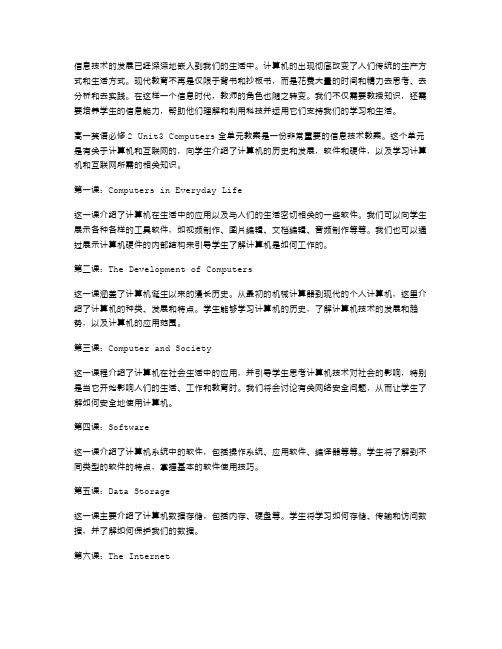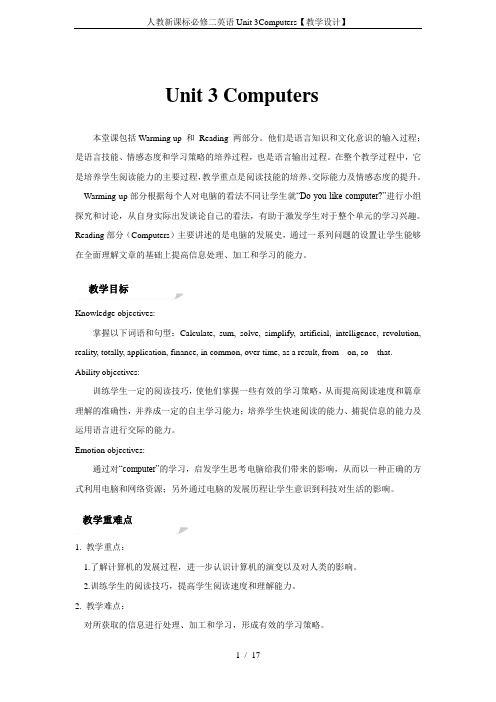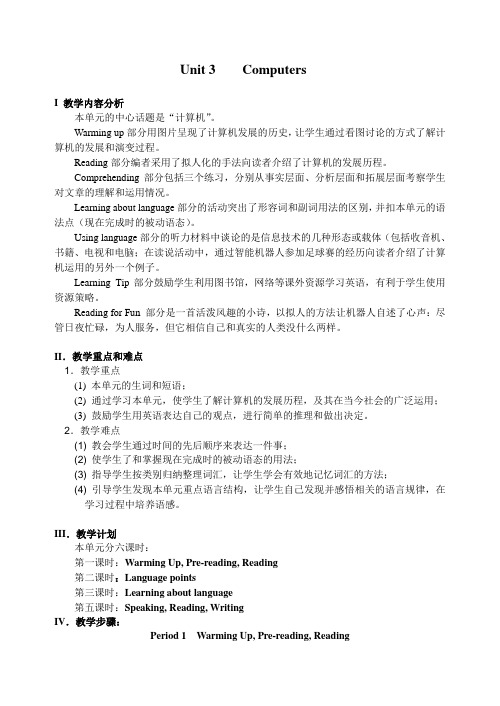Unit3 computes
- 格式:doc
- 大小:53.50 KB
- 文档页数:4

![[推荐精选]Unit 3 Computers 上课教学方案设计](https://img.taocdn.com/s1/m/ddc28a920029bd64783e2c44.png)
Unit 3 Computers 教学设计【单元重点内容与教学目标】本单元的话题是IT技术,计算机的发展史和机器人。
warmingUp部分通过展示算盘、计算器、计算机等图片,引导学生思考计算机的不同形式,并要求学生运用“做决定”的表达。
Pre-reading提出两个问题,引导学生谈论计算机对我们生活的影响。
引起学生对计算机这个话题的兴趣。
Reading部分运用拟人的手法,以第一人称的身份按时间顺序介绍了计算机的发展史。
comprehending部分主要要求学生掌握以时间为线索的的特点,并能通过填写时间表来归纳出的主要信息。
LearningaboutLanguage部分的练习引导学生关注新出现的词汇以及形容词和副词的区别;并且通过仿照例子,初步掌握“现在完成时的被动语态”。
UsingLanguage部分的听说读写都是围绕不同形式的信息技术和不同种类的电子计算机各自的优缺点这两个话题展开训练。
而且要求学生在听说读之后,能用上“做决定”、“推理”的表达法和“现在完成时的被动语态”进行报告,学会写作关于机器人话题的。
LearningTip部分建议学生多从图书馆、报刊、杂志、网络等途径,多方面来增加词汇、提高听说读写的能力。
【教学设计】将warmingUp部分与Pre-reading,Reading,comprehending 部分放在同一课时教学,设计成一节阅读课。
将LearningaboutLanguage及workbook(wB)中的UsingStructures放在一起教学,上一节词法、语法课。
把UsingLanguage中的Readingandspeaking部分的阅读布置为课外阅读作业。
将UsingLanguage中的Listeningandwriting,Speakingandwriting(把ReadingandSpeaking中的任务改为“向老师销售电脑”)和writing部分设计成一节语言运用课(1),重点是培养学生“说”的技能。

Unit 3 Computers(精选3篇)Unit 3 Computers 篇1unit 3 computersthe 3rd period: learning about language---the present perfect passive voicegoals: 1. learn the present perfect passive voice.2. help the students master the way of using the correct voice, telling the differences between the active voice and the passive voice.teaching procedures:step 1: revision and lead-in1. check the homework firstex1:1 totally2 revolution3 artificial intelligence4 birth5 simple-minded6 go by7 deal with 8 network 9 truly 10 anywayex2:revolution; network; went by; totally; truly; simple-minded; anyway; deal withex3:1 totally2 amazed3 exciting4 excited5 cheaply6 unlucky2. lead-insay: are you familiar with these computers? can you call them? (ask the ss to distinguish different types of computers.) do you know these new inventions of computer ?a wrist-worn pc has been invented recently.a pen-like computer has already been developed.(show them some pictures and ask them to make somesentences , using the present perfect passive voice.)eg: it’s rather a hot day today! would you like to have a swim after school ?have you ever swum in the blue water world(蓝色水世界)in the oriental suntown (东方太阳城) which has been set up in taizhou?there a beautiful swimming pool has been built .many high buildings have been set up.lots of flowers and trees have been planted.a new bridge has been completed….step2: discoveringask the ss to discover whether these sentences have something in common.. help them to learn the useful structure : the present perfect passive voice.step3: discussion : learning the structuregive some explanations1构成:主动语态被动语态现在完成时 have/has done---------- have/has been done he has been sent to study the new technology in the company.the dirty clothes have not been washed.have the windows been cleaned?how many shopping centers have been built in this city?2. 只有及物动词才有被动语态,不及物动词(词组)没有被动语态, 如:happen, take place,die, appear, disappear, fail, remain, lie, last, sit ,stand, break out, come true, belong to等.如:what has happened to your brother?3.但许多不及物动词加介词或副词构成的短语动词,相当于及物动词,也可以有被动语态。

信息技术的发展已经深深地嵌入到我们的生活中。
计算机的出现彻底改变了人们传统的生产方式和生活方式。
现代教育不再是仅限于背书和抄板书,而是花费大量的时间和精力去思考、去分析和去实践。
在这样一个信息时代,教师的角色也随之转变。
我们不仅需要教授知识,还需要培养学生的信息能力,帮助他们理解和利用科技并运用它们支持我们的学习和生活。
高一英语必修2 Unit3 Computers全单元教案是一份非常重要的信息技术教案。
这个单元是有关于计算机和互联网的,向学生介绍了计算机的历史和发展,软件和硬件,以及学习计算机和互联网所需的相关知识。
第一课:Computers in Everyday Life这一课介绍了计算机在生活中的应用以及与人们的生活密切相关的一些软件。
我们可以向学生展示各种各样的工具软件,如视频制作、图片编辑、文档编辑、音频制作等等。
我们也可以通过展示计算机硬件的内部结构来引导学生了解计算机是如何工作的。
第二课:The Development of Computers这一课涵盖了计算机诞生以来的漫长历史。
从最初的机械计算器到现代的个人计算机,这里介绍了计算机的种类、发展和特点。
学生能够学习计算机的历史,了解计算机技术的发展和趋势,以及计算机的应用范围。
第三课:Computer and Society这一课程介绍了计算机在社会生活中的应用,并引导学生思考计算机技术对社会的影响,特别是当它开始影响人们的生活、工作和教育时。
我们将会讨论有关网络安全问题,从而让学生了解如何安全地使用计算机。
第四课:Software这一课介绍了计算机系统中的软件,包括操作系统、应用软件、编译器等等。
学生将了解到不同类型的软件的特点,掌握基本的软件使用技巧。
第五课:Data Storage这一课主要介绍了计算机数据存储,包括内存、硬盘等。
学生将学习如何存储、传输和访问数据,并了解如何保护我们的数据。
第六课:The Internet这一课介绍了互联网的原理和应用。

Unit 3 Computers本堂课包括Warming up 和Reading 两部分。
他们是语言知识和文化意识的输入过程;是语言技能、情感态度和学习策略的培养过程,也是语言输出过程。
在整个教学过程中,它是培养学生阅读能力的主要过程,教学重点是阅读技能的培养、交际能力及情感态度的提升。
Warming up部分根据每个人对电脑的看法不同让学生就“Do you like computer?”进行小组探究和讨论,从自身实际出发谈论自己的看法,有助于激发学生对于整个单元的学习兴趣。
Reading部分(Computers)主要讲述的是电脑的发展史,通过一系列问题的设置让学生能够在全面理解文章的基础上提高信息处理、加工和学习的能力。
Knowledge objectives:掌握以下词语和句型:Calculate,sum, solve, simplify, artificial, intelligence, revolution,reality, totally, application, finance, in common, over time, as a result, from···on, so···that. Ability objectives:训练学生一定的阅读技巧,使他们掌握一些有效的学习策略,从而提高阅读速度和篇章理解的准确性,并养成一定的自主学习能力;培养学生快速阅读的能力、捕捉信息的能力及运用语言进行交际的能力。
Emotion objectives:通过对“computer”的学习,启发学生思考电脑给我们带来的影响,从而以一种正确的方式利用电脑和网络资源;另外通过电脑的发展历程让学生意识到科技对生活的影响。
1. 教学重点:1.了解计算机的发展过程,进一步认识计算机的演变以及对人类的影响。
2.训练学生的阅读技巧,提高学生阅读速度和理解能力。

Unit 3 ComputersI 教学内容分析本单元的中心话题是“计算机”。
Warming up部分用图片呈现了计算机发展的历史,让学生通过看图讨论的方式了解计算机的发展和演变过程。
Reading部分编者采用了拟人化的手法向读者介绍了计算机的发展历程。
Comprehending部分包括三个练习,分别从事实层面、分析层面和拓展层面考察学生对文章的理解和运用情况。
Learning about language部分的活动突出了形容词和副词用法的区别,并扣本单元的语法点(现在完成时的被动语态)。
Using language部分的听力材料中谈论的是信息技术的几种形态或载体(包括收音机、书籍、电视和电脑;在读说活动中,通过智能机器人参加足球赛的经历向读者介绍了计算机运用的另外一个例子。
Learning Tip部分鼓励学生利用图书馆,网络等课外资源学习英语,有利于学生使用资源策略。
Reading for Fun 部分是一首活泼风趣的小诗,以拟人的方法让机器人自述了心声:尽管日夜忙碌,为人服务,但它相信自己和真实的人类没什么两样。
II.教学重点和难点1.教学重点(1) 本单元的生词和短语;(2)通过学习本单元,使学生了解计算机的发展历程,及其在当今社会的广泛运用;(3)鼓励学生用英语表达自己的观点,进行简单的推理和做出决定。
2.教学难点(1) 教会学生通过时间的先后顺序来表达一件事;(2) 使学生了和掌握现在完成时的被动语态的用法;(3) 指导学生按类别归纳整理词汇,让学生学会有效地记忆词汇的方法;(4) 引导学生发现本单元重点语言结构,让学生自己发现并感悟相关的语言规律,在学习过程中培养语感。
III.教学计划本单元分六课时:第一课时:Warming Up, Pre-reading, Reading第二课时:Language points第三课时:Learning about language第五课时:Speaking, Reading, WritingIV.教学步骤:Period 1 Warming Up, Pre-reading, ReadingTeaching Goals:1. To know something about computers.2. To learn and talk about computers.Teaching Procedures:Step 1. Leading-inPurpose: To activate the Ss and arouse them to talk about the importance of computers in modern society.Ask Ss whether they have a computer or not and what they use it for. Let them talk as much as possible.Step 2. Warming UpPurpose: To get Ss to think about the differe nt ways computers can be made.Pair workGet Ss to look at the following pictures, and then ask them to answer the questions.A huge computer A PCA notebook computer A calculatorAn abacus1. What are they?2. What do they have in common?3. What is a computer?Suggested Answers:1. a huge computer, a personal computer, a notebook computer, a calculator, an abacus2.(1) to be used to calculate;(2) operate by human beings;(3) they are all artificial;(4) show figures in a certain way.3. A computer is a machine which stores knowledge in its memory and does calculations onthat knowledge. This knowledge is stored in symbols; it is called data. A computer usually has a monitor to show results. However, some computers can speak; these computers can be used for voice mail.A computer is now almost always an electronic device. It usually contains materials whichare toxic; these materials will become toxic waste when disposed of. When a new computer is purchased in some places, laws require that the cost of its waste management must also be paid for. This is called product stewardship.Step 3. Pre-readingPurpose: To activate Ss’ interest about computers.Group workAsk Ss the following questions and encourage them to say more.1.How have computers changed our lives ?2.What do you know about computers ?Suggested Answers:1. They’re a much more useful and humane tool than the phone , and with corporate America behind them the networks will be everywhere--- changing our lives more than any technology since the automobile.2. A multi-function electronic device that can execute instructions to perform a task.A device that accepts information, processes it, and supplies an output. A computer usually contains memory, a control unit, arithmetic and logical units, and a means for input and output.A programmable hardware component that is controlled by internally stored programs and that can perform substantial computations (including arithmetic and logic operations) without human intervention. A computer typically consists of one or more processing units, memory units, and associated peripheral input and output devices.Step 4. Reading1. SkimmingPurpose: 1. To get a brief understanding of the text.2. To train the students’ listening ability.First, let Ss skim the text and then listen to the recording of the text. Pay attention to the pauses and pronunciation.2. ScanningPurpose: To get Ss to have some details in the text.Now we are to read the text again and underline all the expressions in the text. Writethem down in your notebook.3. Further ReadingPurpose: To get Ss to get more details about the text.Read the text again and find the information to complete the table, which describes thedevelopment of computer.1642: ___________________________________________________1822: The Analytical Machine was made by Charles Babbage.____: ___________________________________________________1940s: ________________________________________________________: The first family of computers was connected to each other.1970s: ___________________________________________________Now: ___________________________________________________Step 5. RetellPurpose: To have a deep understanding of the text.Ask Ss to use the chart above to retell the development of the computer.One possible version:I, a computer, was a calculating machine in 1642 in France. Then I was built as an Analytical Machine in 1822, which was a technological revolution. I became a “universal machine” in 1936 to solve any mathematical problem. I was not very big at first then I became huge, the size of a large room before I was made smaller and smaller.Getting new transistors, later very small chips I changed my shape. I was connected with other computers and turned out to part of a network in the early 1960s. In 1970s I was brought into people’s homes, and came the Internet.Step 6. Homework1. Write a short passage about the development of computers.2. Finish Ex1 (P19), Ex2 (P20).Period 2 Language pointsStep 1 Word studyGroup workDivide Ss into four groups and ask them to discuss the following words.1. common(1)most widely known; ordinary:Eg He is a common sailor.(2)have nothing/little/something/ a lot in commonEg At first, I think we only had one thing in common, but suddenly I felt we had a lotin common.Eg The two brothers had everything in common in their manners, but the two sisters have little in common.Eg They have nothing in common with one another.2. analytical分析的Eg The scientist analyzed the milk and found it contained too much water.3.technology 科技;技术Eg With the development of technology, we will cure AIDS sooner or later.4.calculate(v.)1)to use numbers to find out a total amount, distance, etc. 计算;核算We haven’t really calculated the cost of the vacation yet.2)to guess sth by using all the information available 推测,估计It is impossible to calculate what influence he had on her life.5.As time went by, I was made smaller.随着时间的推移,我被弄得越来越小。
Unit 3 Computers I. 单元教学目标II. 目标语言III. 教材分析与教材重组1. 教材分析本单元以computers为话题,旨在通过单元教学,综合听、说、读、写等多种形式,使学生了解计算机和信息技术的产生和发展过程及其在我们的学习、工作、娱乐等生活中所起的重要作用,激发学生对信息技术的兴趣。
1.1 Warming up提供几幅与计算机有关的图片,形象地说明了计算机的发展历程,并用三个问题引发学生对这一话题的思考,从而起到热身的作用。
1.2 Pre-reading根据文章内容预设问题,检查学生对computers相关知识及应用的了解。
学生对computers的了解可能参差不齐,这更能激发学生想获取更多知识的欲望,从而引出下面的阅读文章——WHO AM I?。
1.3 Reading中以别致的标题WHO AM I?引起学生的好奇心,使学生迫不急待地阅读这篇文章,并判断出“I”是computer,从而对文章的内容印象更深刻。
文章以第一人称的形式按时间先后顺序讲述了computers的产生、发展和现状,并用拟人化的口吻表达了computers乐于为人类服务的精神。
1.4 Comprehending 1 通过scanning的方式完成反映计算机发展历程的时间进程;2 通过填表的形式帮助学生宏观梳理文章结构,找出每个段落的主题句(论点)及具体的支持性论据;3 是读后讨论,要求学生结合自己的生活实际讨论计算机如何改变了我们的生活。
1.5 Learning about language分词汇(Discovering useful words and expressions)和语法(Discovering useful structures)两大部分。
Discovering useful words and expressions 1 根据单词释义写出相对应的词汇,考查学生对WHO AM I? 文章中的重要词汇及短语的理解。
教材词汇要记牢(1-8册已学词汇) Ⅰ.阅读单词——我会认1.laptop n.手提电脑2.analytical adj.分析的3.sum n.总数;算术题;金额4.artificial adj.人造的;假的5.designer n.设计师6.chip n.碎片;芯片7.network n.网络;网状物8.web n.网9.Mars n.火星10.supporting adj.支持的;支撑的11.programmer n.程序员;程序师12.teammate n.同伴;伙伴13.mop n.拖把v t.用拖把拖;擦14.naughty adj.顽皮的;淘气的15.niece n.侄女;甥女16.spoil v t.损坏;宠坏Ⅱ.重点单词——我会写1.revolution n.革命2.tube n.管;管子;电子管3.mobile adj.可移动的;机动的4.rocket n.火箭5.explore v t.& v i.探索;探测;探究6.anyhow ad v.(也作anyway)无论如何;即使如此7.goal n.目标;目的;球门;(进球)得分8.happiness n.幸福;快乐9.download v t.下载10.virus n.病毒11.signal v i.& v t.发信号n.信号12.type n.类型v t.& v i.打字13.coach n.教练14.arise v i.(arose,arisen)出现;发生15.electronic adj.电子的16.character n.性格;特点Ⅲ.拓展单词——我会变1.universal adj.普遍的;通用的;宇宙的→universe n.宇宙→universally ad v.普遍地;一致地2.simplify v t.简化→simple adj.简单的→simply ad v.简直;只;不过3.operator n.(电脑)操作员;接线员→operate v.操作;做手术→operation n.操作;手术4.logical adj.合逻辑的;合情理的→logically ad v.逻辑上;合逻辑地;有条理地5.technology n.工艺;科技;技术→technological adj.科技的6.intelligence n.智力;聪明;智能→intelligent adj.智能的;聪明的7.solve v t.解决;解答→solution n.解决办法8.reality n.真实;事实;现实→real adj.真实的9.personal adj.私人的;个人的;亲自的→personally ad v.就个人而言;亲自→personality n.个性;人格10.total adj.总的;整个的n.总数;合计→totally ad v.完全地;整个地11.application n.应用;用途;申请→apply v.运用;涉及;申请→applicant n.申请人;求职者12.finance n.金融;财经→financial adj.金融的;财经的→financially ad v.经济上;财政上;金融上13.appearance n.外观;外貌;出现→appear v.出现;到场14.calculate v t.计算→calculator n.计算器Ⅳ.核心短语1.have...in common有……共同之处2.from...on从……时起3.as a result结果4.by oneself独立地5.in a way在某种程度上6.make up编制,编造;组成;和好7.after all毕竟;终究8.with the help of 在……的帮助下9.deal with处理;安排;对付10.watch over看守;监视增加词汇来助力(9-10册未学词汇)1.reference/'refərəns/n.参考2.precise/pr I'sa I s/adj.精确的,准确的3.simplify/'s I mpl I fa I/v t.单一化,简单化4.portable/'pɔːtəbl/adj.轻便的;手提的;便携的5.shortcoming/'ʃɔːtˌkʌm Iŋ/n.缺点;短处6.update/ʌp'de I t/v t.更新7.tendency/'tendəns I/n.趋向,倾向8.reliable/r I'la Iəbl/adj.可靠的,可信赖的9.swoop/swuːp/v i.突降;猛扑10.parcel/'pɑːsl/n.小包;包裹经典句式需悟通1.I developed very slowly and it took nearly two hundred years before I was built as an analytical machine by Charles Babbage.我发育缓慢,差不多到了两百年之后,查尔斯·巴比奇才把我制成了一台分析机。
高一年级英语必修二第三单元教学设计姓名:邓丽琼班级:340、343Unit 3Computers一、教学设计思路本课设计以WHO AM I?为课堂教学材料,以学生现实生活为出发点和归宿点,旨在发展学生的语言实际运用能力。
本设计以学生中心,运用了图示理论,采用了pair work, group work, class work等活动形式,串联成环,前后环环相扣,帮助学生理解课文,用自己的英语重新诠释课文,并初步具备知识迁移能力。
二、学习任务分析本单元的中心话题是“计算机”,内容涉及计算机的发展历史、计算机的应用等,其中还谈到包括计算机在内的几种信息技术的载体、智能计算机的发明等等。
不过,整个单元多以计算机为第一人称进行自白,这种拟人的手法使得文章谈起来妙趣横生,抽象的专业知识介绍起来也浅显易懂。
本主旨语篇WHO AM I ?以计算机的口吻自述其发展演变的历史以及计算机在当今世界各个领域的运用。
表达了计算机的发展变化之快以及在生活中用途之广。
三、学习者分析计算机这一话题虽然有趣,但本单元所选语言材料属于科普类说明文,内容较为抽样,文章中也不乏一些专业术语,对于高一学生来说有一定的难度。
目前,学生上课以interpersonal交流为主,而interpretative和presentational 形式比重不够。
由于文化教学不够重视,学生的跨文化意识不高。
此外,学生跨学科学习的意识不够,语言和信息的双向促进关系的认识不够。
对于比较策略主要运用在英汉汉英互译的语言层面,未进入文化比较和思维比较。
学生的课外语言活动环境不够丰富和重视程度不够,通常以词汇、语法和写作练习为主,缺乏真实的语言运用。
四、教学目标(1) Language Skills:1. Use “decision making”expressions like “I believe... in my opinion, etc”correctly.(activity 1)2. Develop their predicting and reorganizing skills.(activity 2,3,4,6)3. Write an 100-word passage on “My Robot Friend----Alice”(Task)(2) Language Knowledge:1. Reorganize and share their background information of computers.(activity 1)2. Find and retell the grammar structure of the Present Perfect Passive Voice. (activity 5)(3) Emotions and Attitudes1. 通过讨论,能归纳和陈述网络给学校带来的影响;2. 通过辩论,能对外来网络充满好奇,激发自己的创造力的同时形成健康的网络使用态度和习惯。
Unit3computers知识点一、计算机的发展历程计算机的发展可以追溯到古代,人们使用算盘等工具进行计算。
然而,现代计算机的发展始于 20 世纪。
在20 世纪 40 年代,第一台电子计算机ENIAC 诞生。
它体积巨大,使用了大量的真空管,运算速度相对较慢。
随着技术的进步,晶体管取代了真空管,使得计算机变得更小、更可靠、更节能。
集成电路的出现进一步推动了计算机的发展,将大量的晶体管集成在一个芯片上。
微处理器的发明使计算机变得更加小巧和强大,个人计算机逐渐普及。
从台式机到笔记本电脑,再到如今的平板电脑和智能手机,计算机的形态不断变化。
二、计算机的组成部分计算机主要由硬件和软件两大部分组成。
硬件包括中央处理器(CPU)、内存、硬盘、显示器、键盘、鼠标等。
CPU 是计算机的核心,负责执行指令和进行计算。
内存用于暂时存储正在运行的程序和数据,而硬盘则用于长期存储大量的信息。
显示器用于显示图像和文字,键盘和鼠标是输入设备,用于向计算机输入指令和数据。
软件分为系统软件和应用软件。
系统软件如操作系统(Windows、Mac OS、Linux 等),负责管理计算机的资源和提供基本的服务。
应用软件则是为了满足用户特定的需求,如办公软件(Word、Excel、PowerPoint)、图像处理软件(Photoshop)、游戏等。
三、计算机的工作原理计算机的工作原理基于二进制。
所有的数据和指令都以 0 和 1 的形式存储和处理。
当我们打开计算机并运行一个程序时,程序和相关的数据被加载到内存中。
CPU 从内存中读取指令,并按照指令进行操作。
例如,计算两个数的加法,CPU 会从内存中获取这两个数,进行加法运算,并将结果存储回内存。
计算机的处理过程遵循着“输入处理输出”的模式。
通过输入设备输入数据,经过 CPU 和其他硬件的处理,最终通过输出设备(如显示器、打印机)输出结果。
四、计算机网络计算机网络使得多台计算机能够相互通信和共享资源。
Unit3 computes
Phrases and sentence structure
一、教学内容分析
本节课学生将学习9个短语一个句型。
对于短语学生必须掌握意思及其用法。
通过对句型的掌握什么是结果状语从句以及so和such在从句中的区别。
二、学情分析
高三学生进行一轮复习,必须要扎实掌握所学短语、句型以及他们的拓展。
三、教学目标
1 知识目标
学生将掌握以下短语句型:
1. from on
2.deal with
3. as a result
4.watch over
5.so that
6.be∕grow crazy about
7.in a way 8.make up
9.with the help of 10.after all
2 能力目标
掌握短语句型在题中的用法,特别是高考中的用法。
3情感目标
①自主学习锻炼学生自学能力。
②合作探究培养学生合作意识。
四、教学重、难点。
1 重点
in a way
as a result
deal with
watch over
be∕grow crazy about
.in a way
make up
with the help of
after all
2 难点
so that
such that
五、教学媒体
Blackboard & Chalk
六、教学过程
Step1 Leading-in 翻译句子
①她一边唱歌,一边跳舞。
②随着岁月的流逝,我们的父母越来越老。
③由于天气不好,我们不得不推迟运动会。
④他虽是国王,但他并不幸福。
⑤记住,你务必照我的样子去做每一件事。
⑥众所周知,吸烟对人的健康有害。
Step2 .Phrases and trsanslation
①from on 从…时起
②as a result 结果
③in a way 在某种程度上
④with the help of 在某人的帮助下
⑤deal with 处理
⑥watch over 看守监视
⑦so that 如此…以致于
注:叫学生翻译句子翻译之前先讨论〈同桌之间〉
①昨晚他睡得很晚,结果他今天上课迟到了
He stayed up late last night,As a result ,he was late for school this morning.
②他是如此可爱的一个男孩以致于我们都喜欢他
He is so lovely a boy that everybody loves him.
③在某种程度上我同意你在会议上所说的
In a way, I agree with what you said at the meeting
④在同桌的帮助下我在英语方面取得了很大进步
I made greet progress in English with the help of my deskmate
⑤我不知道如何处理这个问题
I don’t know how to deal with the problem.
⑥我不在家时你能帮我照看一下我的孩子吗?
Will you please watch over my child while I am out?
Step 3 Practice
1.---I think he is taking an active part in social in a way.
---I agree with you____.
A. in a way
B. by the way
C. in the way
D. on the way
2.The fellow was caught stealing and is now____in the police station.
A. watching over
B. watching out for
C. being watched over
D. being watched out for
3.---Traffic accidents are usually very hard to____
---Sure enough , remember what we ___the last one . It was troublesome.
A. deal with ; did with
B. do with ; dealt with
C. deal with ; do with
D. do with ;deal with
4.---My friend Martin was very sick with a high fever;____, he could neither
eat nor sleep.
A. as a result
B. after all
C. any way
D. otherwise
Step4 探究、讨论
①in a way
as a result (as a result of )
同意替换, 展示关于way的短语及意思
②so that
such that 与定语从句的区别
1) so + 形容词∕副词
many∕few + 可数名词复数
much∕little + 不可数名词+(that)+ 从句
形容词+ a∕an + 可数名词单数
Mary is so lovely that at all like to play with her
Tom is so lovely a boy that,they all like to make friends with him
There are so many flouers that I don’t know how to chovse
So excited was he that he could not speak
2) Such + a∕an + adj + 可数名词单数
adj + 不可数名词复数+(tha t)+ 从句
adj + 不可数名词
He is such a good teacher that we all respect him so good a teacher
These were such difficult questions that none of us could ansuer
这些问题如此难,以至于我们没人回答。
We had such terrible that we couldn’t finish the worle on time
天气这么糟以至于我们没能按时完成作业。
Step5 Consolidation
1.The weather was __cold that I did not like to leave my room.
A.really
B.such
C.too
D.so
2.__that even the people in the next room could hear him.
A.So he spoke loudly
B.So he did speak loudly
C.So loudly did he speak
D.So did he speak loudly
Setp6 Summary 〈这节我们学了什么……〉
Step7 Homework
七、板书设计
八、教学评价
本节课主要以学生为主体,自主合作探究,激发了学生的学习积极性,讨论也积极热烈,课堂气氛活跃,及时巩固,效果很好。
Teaching design of unit 3 computers
组别:英语
姓名:巨艳妮
2014-10-20。